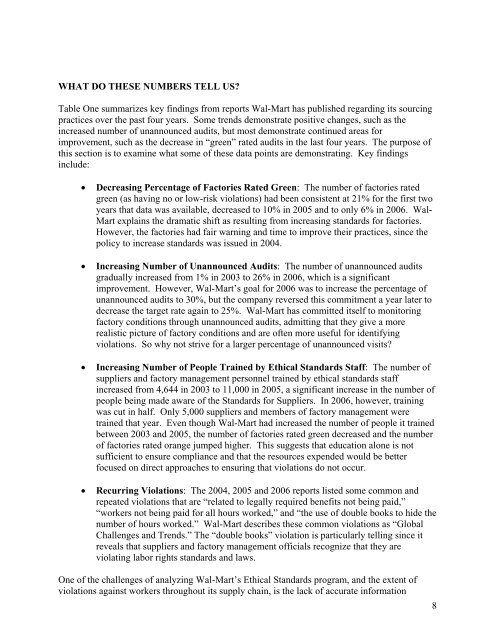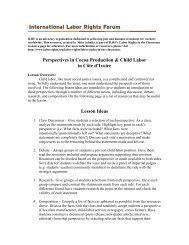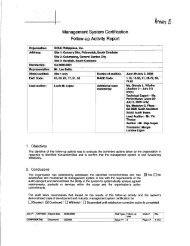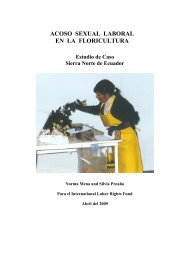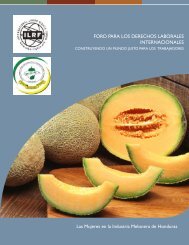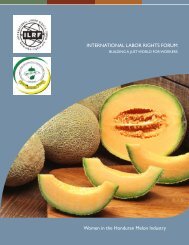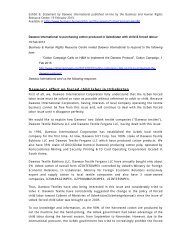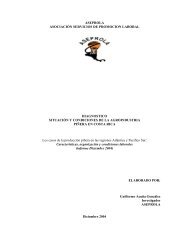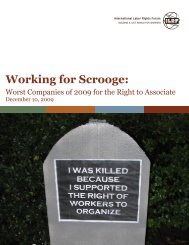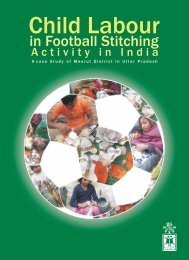Ethical Standards and Working Conditions in Wal-Mart's Supply Chain
Ethical Standards and Working Conditions in Wal-Mart's Supply Chain
Ethical Standards and Working Conditions in Wal-Mart's Supply Chain
Create successful ePaper yourself
Turn your PDF publications into a flip-book with our unique Google optimized e-Paper software.
WHAT DO THESE NUMBERS TELL US?Table One summarizes key f<strong>in</strong>d<strong>in</strong>gs from reports <strong>Wal</strong>-Mart has published regard<strong>in</strong>g its sourc<strong>in</strong>gpractices over the past four years. Some trends demonstrate positive changes, such as the<strong>in</strong>creased number of unannounced audits, but most demonstrate cont<strong>in</strong>ued areas forimprovement, such as the decrease <strong>in</strong> “green” rated audits <strong>in</strong> the last four years. The purpose ofthis section is to exam<strong>in</strong>e what some of these data po<strong>in</strong>ts are demonstrat<strong>in</strong>g. Key f<strong>in</strong>d<strong>in</strong>gs<strong>in</strong>clude:• Decreas<strong>in</strong>g Percentage of Factories Rated Green: The number of factories ratedgreen (as hav<strong>in</strong>g no or low-risk violations) had been consistent at 21% for the first twoyears that data was available, decreased to 10% <strong>in</strong> 2005 <strong>and</strong> to only 6% <strong>in</strong> 2006. <strong>Wal</strong>-Mart expla<strong>in</strong>s the dramatic shift as result<strong>in</strong>g from <strong>in</strong>creas<strong>in</strong>g st<strong>and</strong>ards for factories.However, the factories had fair warn<strong>in</strong>g <strong>and</strong> time to improve their practices, s<strong>in</strong>ce thepolicy to <strong>in</strong>crease st<strong>and</strong>ards was issued <strong>in</strong> 2004.• Increas<strong>in</strong>g Number of Unannounced Audits: The number of unannounced auditsgradually <strong>in</strong>creased from 1% <strong>in</strong> 2003 to 26% <strong>in</strong> 2006, which is a significantimprovement. However, <strong>Wal</strong>-Mart’s goal for 2006 was to <strong>in</strong>crease the percentage ofunannounced audits to 30%, but the company reversed this commitment a year later todecrease the target rate aga<strong>in</strong> to 25%. <strong>Wal</strong>-Mart has committed itself to monitor<strong>in</strong>gfactory conditions through unannounced audits, admitt<strong>in</strong>g that they give a morerealistic picture of factory conditions <strong>and</strong> are often more useful for identify<strong>in</strong>gviolations. So why not strive for a larger percentage of unannounced visits?• Increas<strong>in</strong>g Number of People Tra<strong>in</strong>ed by <strong>Ethical</strong> <strong>St<strong>and</strong>ards</strong> Staff: The number ofsuppliers <strong>and</strong> factory management personnel tra<strong>in</strong>ed by ethical st<strong>and</strong>ards staff<strong>in</strong>creased from 4,644 <strong>in</strong> 2003 to 11,000 <strong>in</strong> 2005, a significant <strong>in</strong>crease <strong>in</strong> the number ofpeople be<strong>in</strong>g made aware of the <strong>St<strong>and</strong>ards</strong> for Suppliers. In 2006, however, tra<strong>in</strong><strong>in</strong>gwas cut <strong>in</strong> half. Only 5,000 suppliers <strong>and</strong> members of factory management weretra<strong>in</strong>ed that year. Even though <strong>Wal</strong>-Mart had <strong>in</strong>creased the number of people it tra<strong>in</strong>edbetween 2003 <strong>and</strong> 2005, the number of factories rated green decreased <strong>and</strong> the numberof factories rated orange jumped higher. This suggests that education alone is notsufficient to ensure compliance <strong>and</strong> that the resources expended would be betterfocused on direct approaches to ensur<strong>in</strong>g that violations do not occur.• Recurr<strong>in</strong>g Violations: The 2004, 2005 <strong>and</strong> 2006 reports listed some common <strong>and</strong>repeated violations that are “related to legally required benefits not be<strong>in</strong>g paid,”“workers not be<strong>in</strong>g paid for all hours worked,” <strong>and</strong> “the use of double books to hide thenumber of hours worked.” <strong>Wal</strong>-Mart describes these common violations as “GlobalChallenges <strong>and</strong> Trends.” The “double books” violation is particularly tell<strong>in</strong>g s<strong>in</strong>ce itreveals that suppliers <strong>and</strong> factory management officials recognize that they areviolat<strong>in</strong>g labor rights st<strong>and</strong>ards <strong>and</strong> laws.One of the challenges of analyz<strong>in</strong>g <strong>Wal</strong>-Mart’s <strong>Ethical</strong> <strong>St<strong>and</strong>ards</strong> program, <strong>and</strong> the extent ofviolations aga<strong>in</strong>st workers throughout its supply cha<strong>in</strong>, is the lack of accurate <strong>in</strong>formation8


